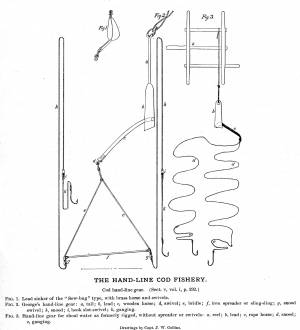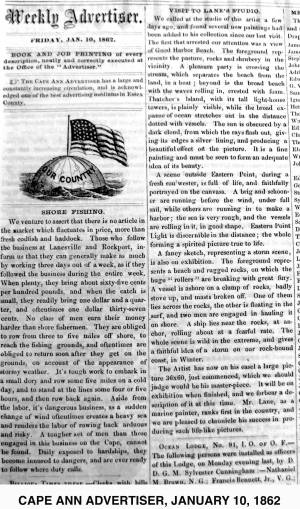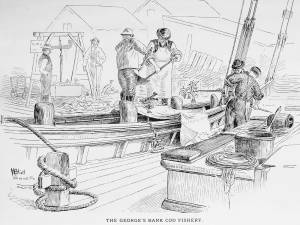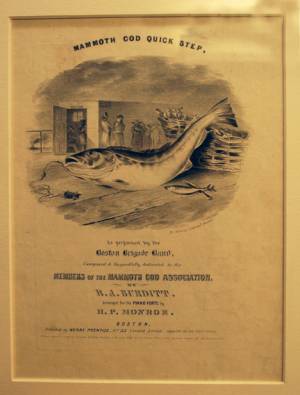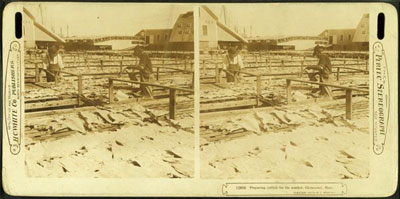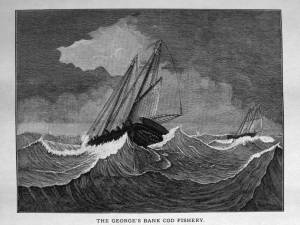An online project under the direction of the CAPE ANN MUSEUM
Historical Materials: Maritime & Other Industries & Facilities
Historical Materials » Maritime & Other Industries & Facilities » Cod / Cod Fishing
Cod / Cod Fishing
View related Fitz Henry Lane catalog entries (4) »
Cod fishing with hand-lines (hand-lining) from the deck of a schooner was the predominant method used on offshore fishing grounds prior to the Civil War. Offshore grounds included the Grand Banks of Newfoundland, the banks off Nova Scotia, numerous small grounds in the Gulf of Maine, and Georges Bank.
Hand-lining from dories and wherries was the inshore version of this fishery, the boats being hauled ashore at the end of a day's work.Their fishing grounds ranged from the shoreline to Ipswich Bay, and a multitude of small grounds a mile or two offshore. Colonial fishermen found the inshore grounds off Cape Ann—particularly Ipswich Bay—extremely rich, so much so that these grounds were the prime sources of market fish in that period.
Early the nineteenth century, hand-lining gear had become surprisingly complex, consisting of two hooks with leaders (gangings), swivels, a bridle and spreader, and a 20-pound sinker and staff. This rig was attached to a hand-line which could be as long as 900 feet, depending on the depth and type of bottom being fished. Gear of this size and complexity was coiled and stowed in a tub, instead of being wound on a wood frame.
Inshore fishing gear was much simpler: a line on a wooden winder, a hook at the end, and a sinker hitched to the line at the desired distance from the hook.
– Erik Ronnberg
Related tables: Fishing » // Goode, The Fisheries and Fishing Industries of the United States » // Waterfront, Gloucester »
Steel engraving after drawing in G. Brown Goode, The Fisheries and Fishery Industries of the United States (Washington, DC: Government Printing Office)
8 1/2 x 11 in. (page size)
Cape Ann Museum Library & Archive, Gloucester, Mass.
See pl. 31.
Shows the two basic types of hand-line gear in use in mid-ninteenth century. At left is the Georges gear, developed for fishing on Georges Bank. At right is shoal water gear, as commonly used in the inshore fisheries using dories and other small craft. The spreader, or "sling-ding" was used on this type of gear with the advent of dory hand-lining on offshore grounds.
Also filed under: Hand-lining »
Steel engraving after drawing in G. Brown Goode, The Fisheries and Fishery Industries of the United States (Washington, DC: Government Printing Office, 1883)
8 1/2 x 11 in. (page size)
Cape Ann Museum Library & Archive, Gloucester, Mass.
See pl. 32.
Also filed under: Georges Bank, Mass. » // Hand-lining »
Cape Ann Museum Library & Archive
Also filed under: Drying Fish » // Flake Yard » // Historic Photographs »
Newsprint
Cape Ann Advertiser
Collection of Fred and Stephanie Buck
"VISIT TO LANE'S STUDIO.
We called at the studio of this artist a few days ago, and found several new paintings had been added to his collection since our last visit. The first that arrested our attention was a view of Good Harbor Beach. . . .
A scene outside Eastern Point, during a fresh sou'wester, is full of life, and faithfully portrayed on the canvass. . . .
A fancy sketch, representing a storm scene, is also on exhibition. . . .
The Artist has now on his easel a large picture 36x60, just commenced, which we should judge would be his master-piece. It will be on exhibition when finished, and we forbear a description of it at this time. Mr. Lane, as a marine painter, ranks first in the country, and we are pleased to chronicle his success in producing such life-like pictures."
In G. Brown Goode, The Fisheries and Fishery Industries of the United States (Washington, DC: Government Printing Office)
A vessel having returned from the fishing grounds with a fare of split salted cod, is discharging it at a fish pier for re-salting and drying. The fish are tossed from deck to wharf with sharp two-pronged gaffs, and from there to a large scale for weighing. From there, they will be taken to another part of the wharf for washing and re-salting.
– Erik Ronnberg
Also filed under: Drying Fish » // Fishing » // Georges Bank, Mass. »
T. Moore's Lithography, Boston
12 1/2 x 9 1/2 in.
20 x 16 3/4 in (Framed)
Cape Ann Museum, Museum Purchase (2014.089.2)
Also filed under: Johnston, David Claypoole » // Moore's, T. - Lith. - Boston » // Sheet Music by other artists »
New York Public Library
Also filed under: Drying Fish »
Gravure plate printing on pulp paper in G. Brown Goode The Fisheries and Fishery Industries of the United States (Washington, DC: Government Printing Office)
7 1/2 x 5 7/8 in.
Cape Ann Museum Library & Archives, Gloucester, Mass.
See pl. 30.
Derived with modifications from Lane's painting, /entry:9/, the image depicts fishing in heavy weather on Georges Bank. While Lane's version was intended to depict this fishery in the 1840s, Collins' version shows a dory on the stern davits instead of a yawl boat—a practice that became common after the Civil War.
– Erik Ronnberg
In G. Brown Goode The Fisheries and Fishery Industries of the United States (Washington, DC: Government Printing Office)
See pl. 35.
After landing and weighing, the cod are split and washed, a dory filled with water serving as the wash tub. Once thoroughly rinsed of the coarse first salting, the split cod are piled in the wharf shed where they will be re-salted, usually with a finer grade of salt, and stored in bins or large casks until ready for drying on the fish flakes.
– Erik Ronnberg
Also filed under: Drying Fish »
